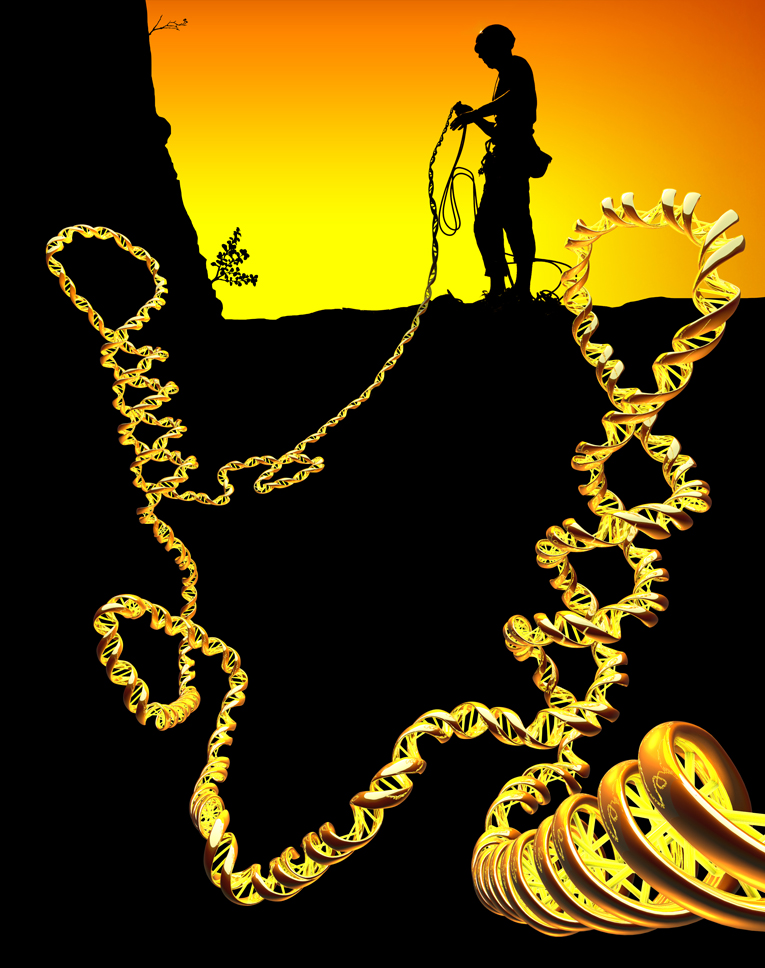Unique recordings of DNA by TU researchers show tightly wound fragments or ‘supercoils’ moving along the strand. This reveals that DNA molecules routinely change shape within a 100th of a second.
It’s been known for almost 60 years that the DNA molecule is shaped as a double helix. But in a cell, the DNA molecules are wound around protein balls, called histones, resulting in a shape like a curled telephone wire. Winding the structure even further results in ‘supercoils’, or tightly wound structures perpendicular to the wire-shape. Have a look at this film for a better concept.
DNA supercoils or ‘plectonemes’ have caught the interest of researchers because they can induce local changes in the DNA structure, which may affect transcription or protein binding. Also, supercoiling may serve to bring distant DNA sequences close together, resulting in new recombinations of genetic code.
“To understand the cellular processes that are affected by supercoiling, it is essential to know the dynamics, of which virtually nothing is known,”, argues Marijn van Loenhout MSc., who published an article on the ‘Dynamics of DNA supercoils‘ in Science on 13 September, together with Professor Cees Dekker (Kavli Institute of Nanoscience at the Faculty of Applied Sciences).
Using the recently improved magnetic tweezers, the researchers wound a DNA molecule (about 7 micrometers long) until supercoils emerged. One side of the DNA strand was attached to the glass base, the other to a floating magnetic bead. They then used magnetic force to flatten the fluorescent DNA molecule, which enabled them to see the supercoil as a denser area under an optical microscope. What’s more: they even filmed it.
They noticed two different kinds of plectoneme movements: slow diffusion and hopping.
Supercoil hopping is an interesting behaviour for DNA for at least two reasons, the researchers argue. It allows for fast and long-range rearrangements of the DNA-structure, “which may explain the fast search times for site juxtaposition of two distant DNA regions.”
Last May, Kavli institute reseachers discovered that a broken DNA molecule is able to locate a similar sequence and uses that as a template for repair. Supercoil hopping may play a role in this process.
Moreover, supercoil hopping illustrates the fast agility of the DNA molecule, even in a coiled state. The fast structure-changes are important for protein binding and gene expression.
Hopping mostly takes place within a 20 millisecond timeframe. Supercoils themselves are generally short-lived (less than 0,1 seconds), but the average lifetime increases (up to 10 seconds) with the applied torque. Distances between a vanishing and newly occurring supercoil measure up to 5 micron (about three- quarters of the entire length of the molecule used). In contrast to diffusion movement, hopping is not hindered by any energy bumps along the way.
Diffusion is the slow movement of supercoils along the DNA strand, in which the DNA slithers (or slips) along itself in the supercoil. The researchers note that the movement is slower than one would expect based on Brownian (thermal-driven) motion, and even more so when the strand is more tightly wound. They propose that a supercoil cannot move freely along the strand, but has to overcome energy bumps along the way. This idea is supported by the observation that supercoils do indeed show preference for certain spots along the DNA molecule.



Comments are closed.